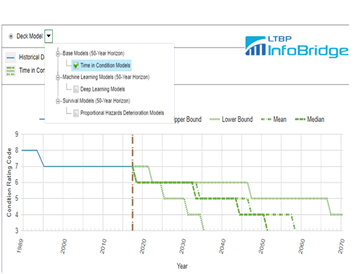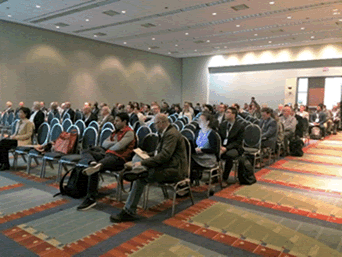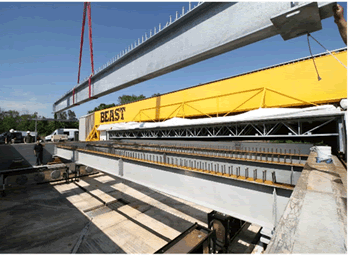U.S. Department of Transportation
Federal Highway Administration
1200 New Jersey Avenue, SE
Washington, DC 20590
202-366-4000
Federal Highway Administration Research and Technology
Coordinating, Developing, and Delivering Highway Transportation Innovations
|
LTBP NEWS This newsletter is an archived publication and may contain dated technical, contact, and link information. |
|
| Publication Number: FHWA-HRT-20-039 Date: Volume 9, Winter 2020 |
Publication Number: FHWA-HRT-20-039 Date: Volume 9, Winter 2020 |

PDF Version (883 KB)
The Long-Term Bridge Performance (LTBP) Program released a new version of InfoBridge in January at the 99th Transportation Research Board (TRB) Annual Meeting. This latest version has many important features, such as:
In addition to these features, the 2019 National Bridge Inventory (NBI)/National Bridge Element (NBE) and additional LTBP field-collected data are also part of this version.
The new bridge deck condition statistical forecasting models implemented in InfoBridge are time-in-condition model, deep learning model, and proportional hazards deterioration model.

Source: FHWA
InfoBridge features three new bridge deck condition forecasting models.
The additions to historical spec changes cover standard specifications from 1931 to 2002 for the following:
The LTBP InfoBridge web portal can be accessed at https://infobridge.fhwa.dot.gov/.

Source: FHWA
LTBP Session at 2020 TRB Annual Meeting, Washington, DC.
Hari Kalla, Associate Administrator of FHWA's Office of Infrastructure, welcomed the session attendees and provided introductory remarks.
Jean Nehme, Team Leader for FHWA's Long-Term Infrastructure Performance (LTIP), provided an update of the 2019 LTBP program activities. Other presentations by LTBP staff included an update on the increased data collection, new features in InfoBridge, three bridge deck condition forecasting models in InfoBridge, and a presentation by Professor Başak Bektaş of Minnesota State University on how InfoBridge is being used in research and education.
|
The session was attended by more than 150 people. The session was sponsored by the TRB Standing Committee on Structures Maintenance (AHD30) and cosponsored by the TRB Standing Committees on Bridge Management (AHD35) and Testing and Evaluation of Transportation Structures (AFF40).
The LTBP Program is conducting an accelerated test on a full-scale steel girder bridge. The program is conducting the test at the Bridge Evaluation and Accelerated Structural Testing (BEAST) Lab at the Rutgers Center for Advanced Infrastructure and Transportation.
The main objective is to understand the causes and rates of deterioration of different bridge components. The bridge design (based on specifications from the 1980s) was chosen to represent most of the similar bridge types in operation today. The single-span bridge is 28 ft wide by 50 ft long, and consists of four steel girders supporting an 8-inch concrete deck. The deck is subjected to a rolling (tandem) live load of 60 kip that imposes 17,500 cycles per day. The bridge also is subjected to one freeze-thaw cycle every 16 hours. Additionally, the deck is sprayed with a 6-percent solution of brine every 16 hours. The environmental and live loading frequency is equivalent to approximately 17 years of loading compressed into 1 year.

© Rutgers University.
BEAST Specimen Bridge Under Construction
The bridge is instrumented with strain gages, thermocouples, linear variable differential transformers, accelerometers, and humidity gages. In addition, visual inspection and several nondestructive evaluation (NDE) measurements are taken on a 1 ft by 1 ft grid after every 14 days of testing. The NDE measurements include electrical resistivity, impact echo, ground-penetrating radar, half-cell potential, ultrasonic shear-wave tomography, ultrasonic surface waves, infrared thermography, and high-definition imaging.
LTBP Program staff will upload all data acquired through this research study onto InfoBridge.
An LTBP Program webinar was presented on Wednesday, March 18, 2020. An LTBP Program progress was presented in addition to recapping the LTBP session held during the 2020 TRB Annual Meeting. Access the recording: 2020 LTBP State Coordinators' Webinar.
InfoBridge: Easy Access
to the National Bridge Inventory and Much More - Part 1
Aspire, The
Concrete Bridge Magazine, Precast/Prestressed Concrete Institute
Winter 2020 [PDF]
Truck Platoons and
Highway Bridges
Aspire, The Concrete Bridge Magazine, Precast/Prestressed Concrete Institute
Summer 2019 [PDF]
Advancing Bridge Repair and Preservation Using Ultra-High Performance Concrete
Aspire, The
Concrete Bridge Magazine, Precast/Prestressed Concrete Institute
Spring 2019 [PDF]
Concrete Bridge Deck
Service-Life Prediction Tools
Aspire, The Concrete Bridge Magazine, Precast/Prestressed Concrete Institute
Winter 2019 [PDF]
Distribution—FHWA LTBP News is being distributed according to a standard distribution. Direct distribution is being made to the FHWA Divisions and Resource Center. Key Words—Infrastructure, Bridges, Research, nondestructive evaluation, NDE, TRB, UHPC. Notice—This document is disseminated under the sponsorship of the U.S. Department of Transportation (USDOT) in the interest of information exchange. The U.S. Government assumes no liability for the use of the information contained in this document. The U.S. Government does not endorse products or manufacturers. Trademarks or manufacturers' names appear in this report only because they are considered essential to the objective of the document. Quality Assurance Statement—The Federal Highway Administration (FHWA) provides high-quality information to serve Government, industry, and the public in a manner that promotes public understanding. Standards and policies are used to ensure and maximize the quality, objectivity, utility, and integrity of its information. FHWA periodically reviews quality issues and adjusts its programs and processes to ensure continuous quality improvement. |
Join us on Facebook and YouTube to find FHWA's latest news, information, and resources.


HRDI-30/03-20(Web)E
FHWA-HRT-20-039
